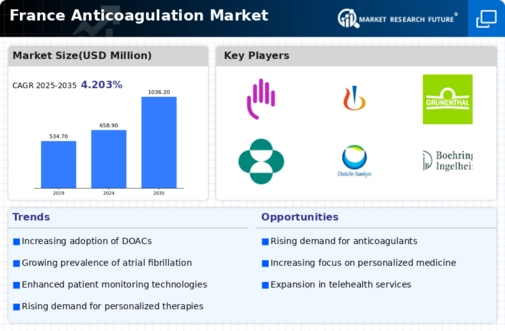Increasing Aging Population
The aging population in France is a critical driver for the anticoagulation market. As individuals age, the risk of thromboembolic disorders, such as atrial fibrillation and deep vein thrombosis, escalates. According to recent statistics, approximately 20% of the French population is over 65 years old, a demographic that is particularly susceptible to these conditions. This demographic shift necessitates a greater demand for anticoagulant therapies, thereby propelling the market forward. Furthermore, the healthcare system in France is adapting to this trend by increasing awareness and screening for thromboembolic risks among older adults. Consequently, the anticoagulation market is likely to experience substantial growth as healthcare providers focus on managing the health of this vulnerable population.
Rising Awareness and Education
There is a growing awareness and education regarding thromboembolic disorders in France, which serves as a significant driver for the anticoagulation market. Healthcare campaigns aimed at educating both patients and healthcare professionals about the risks and management of these conditions have gained momentum. This increased awareness is reflected in the rising number of patients seeking anticoagulant therapies, as they become more informed about their health options. Additionally, healthcare providers are receiving enhanced training on the importance of anticoagulation management, which is crucial for preventing complications. As a result, the anticoagulation market is likely to see a surge in demand, with an estimated increase of 10% in patient enrollment for anticoagulant treatments over the next few years.
Shift Towards Value-Based Care
The shift towards value-based care in the French healthcare system is influencing the anticoagulation market. This model emphasizes patient outcomes and cost-effectiveness, prompting healthcare providers to focus on delivering high-quality care while managing expenses. As a result, there is a growing emphasis on anticoagulant therapies that demonstrate clear clinical benefits and cost savings. Payers are increasingly interested in therapies that reduce hospitalizations and complications associated with thromboembolic disorders. This trend is likely to drive the development and adoption of innovative anticoagulant solutions that align with value-based care principles, potentially leading to a market growth of around 8% in the coming years.
Regulatory Support for Anticoagulants
Regulatory bodies in France are increasingly supportive of anticoagulant therapies, which significantly influences the anticoagulation market. The French National Authority for Health (HAS) has been proactive in evaluating and approving new anticoagulant medications, ensuring that patients have access to the latest treatments. This regulatory environment fosters innovation and encourages pharmaceutical companies to invest in research and development. For instance, the approval of novel oral anticoagulants has expanded treatment options for patients, leading to a projected market growth of approximately 15% over the next five years. The supportive regulatory framework not only enhances patient access to effective therapies but also stimulates competition among manufacturers, ultimately benefiting the anticoagulation market.
Technological Advancements in Monitoring
Technological advancements in monitoring anticoagulation therapy are transforming the anticoagulation market in France. Innovations such as point-of-care testing devices and mobile health applications are enabling more efficient management of anticoagulant therapies. These technologies allow for real-time monitoring of patients' coagulation levels, facilitating timely adjustments to medication dosages. The integration of technology into patient care is expected to enhance adherence to treatment protocols, thereby reducing the incidence of adverse events. As a result, the anticoagulation market is projected to grow by approximately 12% as healthcare providers increasingly adopt these advanced monitoring solutions to improve patient outcomes.

















Leave a Comment